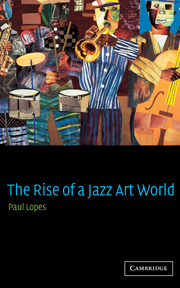Book contents
- Frontmatter
- Contents
- Acknowledgments
- Introduction: The quest for cultural legitimacy
- 1 Before the Jazz Age: professional musicians and good music
- 2 The Jazz Age: professional musicians and the cultivated vernacular
- 3 The swing craze: professional musicians, swing music, and the art of improvisation
- 4 The rise of a jazz art world: jazz enthusiasts, professional musicians, and the modernist revolt
- 5 The New Jazz Age: the jazz art world and the modern jazz renaissance
- Conclusion: The jazz art world and American culture
- Bibliography
- Index
Introduction: The quest for cultural legitimacy
Published online by Cambridge University Press: 22 September 2009
- Frontmatter
- Contents
- Acknowledgments
- Introduction: The quest for cultural legitimacy
- 1 Before the Jazz Age: professional musicians and good music
- 2 The Jazz Age: professional musicians and the cultivated vernacular
- 3 The swing craze: professional musicians, swing music, and the art of improvisation
- 4 The rise of a jazz art world: jazz enthusiasts, professional musicians, and the modernist revolt
- 5 The New Jazz Age: the jazz art world and the modern jazz renaissance
- Conclusion: The jazz art world and American culture
- Bibliography
- Index
Summary
I say this because jazz, the music I play most often, has never really been accepted as an art form by the people of my own country … I believe that the great mass of the American people still consider jazz as lowbrow music … To them, jazz is music for kids and dope addicts. Music to get high to. Music to take a fling to. Music to rub bodies to. Not “serious” music. Not concert hall material. Not music to listen to. Not music to study. Not music to enjoy purely for its listening kicks.
Dizzy Gillespie, “Jazz Is Too Good For Americans,” Esquire, June 1957: 55In 1957 jazz trumpeter Dizzy Gillespie criticized the continued lack of respect in America for jazz as more than a lowbrow entertainment. Gillespie's criticism came surprisingly at a time when jazz was enjoying a resurgence in national recognition as well as a booming commercial market in recordings and live performances. It was in fact the peak of a renaissance in jazz music – a rebirth of jazz as a high art movement that over the two decades of the 1950s and 1960s transformed American music. Inspired in the 1940s by a new style of jazz called bebop, musicians during the renaissance explored various styles of jazz performance, composition, and improvisation.
- Type
- Chapter
- Information
- The Rise of a Jazz Art World , pp. 1 - 10Publisher: Cambridge University PressPrint publication year: 2002



